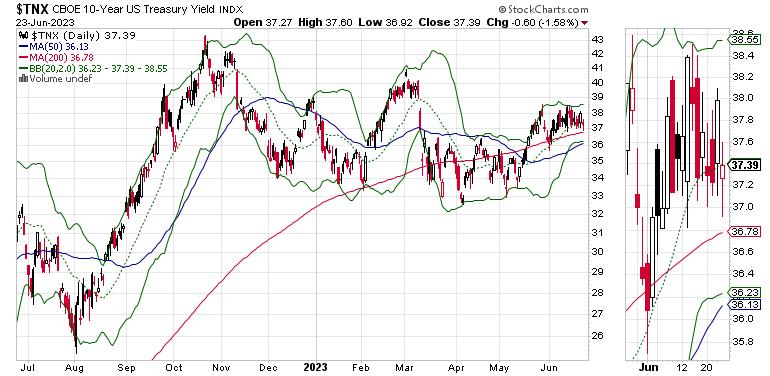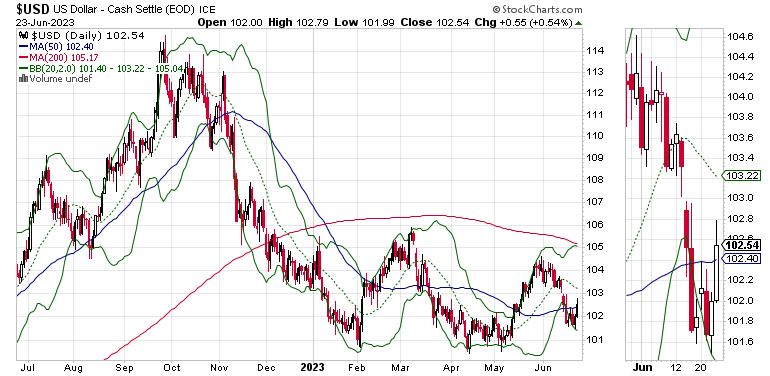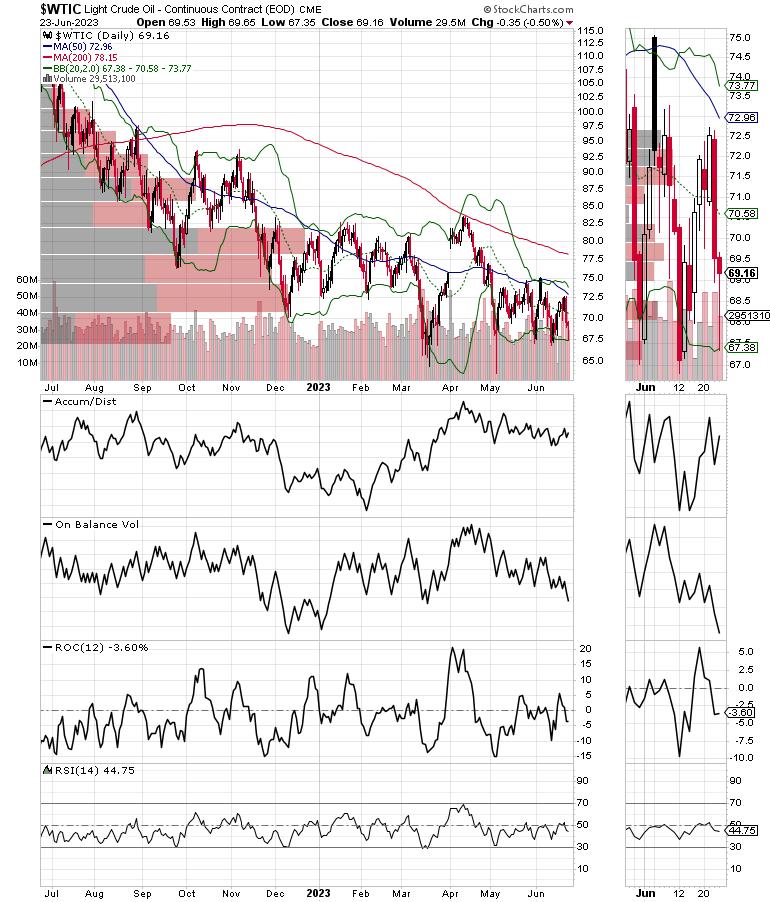| Followers | 679 |
| Posts | 140943 |
| Boards Moderated | 36 |
| Alias Born | 03/10/2004 |
Monday, June 26, 2023 8:40:00 AM
NYAD Breaks Below 50-day Moving Average
By: Joe Duarte | June 26, 2023
By the time this article hits the presses, there may be a fully developing civil war in Russia.
Two weeks ago in this space, I noted that the AI-fueled rally was due for a pullback. And the Fed and a cadre of central banks gave sellers the excuse to take profits.
And just to make life interesting, the news of major problems in Russia broke over the weekend and are rapidly developing as I go to press. Reports suggest that the leader of Russia's mercenary group, Wagner, is trying to implement a coup against Putin. And Putin is retaliating. The situation seems to be deteriorating rapidly as there are reports of clashes between Wagner fighters and Russia's military in southern Russia.
Let's See What the Fed Does
Fed Chairman Powell, in his recent congressional testimony, warned that the central bank would resume its interest rate hiking cycle as inflation isn't where the central bank wants it. His comments coincided with worse-than-expected inflation news from the UK, which registered 7.1% year-over-year growth in its core inflation measure. The Eurozone's core inflation seems to be slowing as the region is now in a confirmed recession. In the US, Consumer prices remain elevated but are flattening out, while producer prices plunged in the latest report.
So, is Powell just talking? Who knows? But with the situation in Russia rapidly deteriorating, what the Fed and other global central banks do next is anyone's guess. What is most likely is that the events in Russia will increase volatility in the US dollar, gold, crude oil, U.S. Treasury bonds, and, of course, stock index futures.
Of course, these events in Russia couldn't come at a worse time, since the Bank of England, the Swiss National Bank, and the central bank of Norway all raised interest rates on June 22, 2023, with expectations rising for more rate hikes from the European Central Bank and tough talk from the Fed about raising rates two more times in 2023. Furthermore, the rise in US jobless claims continues. This time, California, Connecticut, and New Jersey led the way as tech layoffs may be gathering steam. Existing home sales were flat year-over-year as the usual supply shortage, combined with mortgage rates, continued to have a negative effect. New home sales are not struggling. Meanwhile, the US leading economic indicator fell for the 14th straight month.
This comes as PMI data shows the manufacturing component of global and US PMIs is slowing rapidly, as new orders are drying up and the services sector is showing signs of slowing.
Watching the Bond Market; Global Economy Shows Signs of Slowing as Russian Events Develop
The bond market's reaction to talk of inflation and higher interest rates is, in many ways, more important than what influential people say or do. That's because bonds are the most inflation-sensitive financial instruments available. At the same time, US Treasury bonds are considered the ultimate flight to safety instruments in the world. That notion is about to be tested as the Russian situation develops.

You can see that, although yields initially rose on Powell's testimony and the global rate hikes, by week's end, the 10-year US Treasury Yield index ($TNX) remained well below the highs reached in late 2022. If history is any guide, the Russian events should lead to big money moving into U.S. treasuries and lower yields.
Watch the 3.6% yield zone on the downside and 3.85% on the upside. If treasuries react to this developing crisis as they have in the past, we may see a significant drop in bond yields.

The US Dollar index ($USD) is also worth watching. Keep an eye on the 103-105 trading range. Moves above or below that will be meaningful if they last.

Also watch the action in crude oil ($WTIC) as traders begin to handicap the potential for Russian oil supplies, which have been quietly flooding the world of late, to be disrupted.

We'll also be watching what happens to mortgage rates and the housing market, especially the homebuilder stocks in the U.S., as the Russian situation develops. Depending on how the markets react, lower yields may have positive effects on home builders and REITs.
That's because with lower bond yields, as the chart above shows, we're already seeing an increase in mortgage activity.
Incidentally, thanks to all the members and followers who have joined my Buy me a Coffee page, where I expect to be very busy in the next few days and send Flash Alerts to subscribers. Meanwhile, you can check out my Weekly Real Estate Roundup here and here. That's where I offer crucial market updates in an easy-to-follow and highly accessible format. This crucial information complements the stock picks at Joe Duarte in the Money Options.com.
Bullish and Bearish Stock Sectors
It's also important to see how stocks see Mr. Powell's remarks and the Russian developments will be reflected in money flows, especially in a sector-specific manner.
The market's recent leadership, technology and homebuilders went in opposite directions, with the homebuilders ($SPHB) pushing higher due to the long-term demographic megatrends, which continue to exert their bullish influence on the group.

The highly overbought semiconductors ($SOX) continued their pullback, but held at their 20-day moving average (MA) as the crowd who missed the first leg of the rally buy on the dip.

Perhaps the most interesting action was in the retail sector (RLX), where the bargain shopper subsector is getting a bid from investors who are starting to price in a recession.

All the above charts show the relationship between the action in TNX and the particular sector of interest.
NYAD Breaks Below 50-day Moving Average
The New York Stock Exchange Advance Decline line ($NYAD) finally gave in to selling pressure last week as it broke below its 50-day moving average. NYAD had been hanging in there fairly well, but did not confirm the recent highs on the major indexes delivering a negative divergence. Unless this break below the 50-day MA is repaired soon, we'll have to see what happens at the 200-day MA.

The Nasdaq 100 Index ($NDX) is in correction mode. The first major support is the 20-day MA. The Accumulation Distribution Line and On Balance Volume (OBV) have turned short-term negative.

The S&P 500 index ($SPX) is also in a short-term reversal mode. Both Accumulation/Distribution and OBV have turned negative as sellers make a comeback.

VIX Is Likely to Bounce
After its recent new lows, the Cboe Volatility Index ($VIX) is poised to rise as the Russian developments proceed.
When the VIX rises, stocks tend to fall, as rising put volume is a sign that market makers are selling stock index futures to hedge their put sales to the public. A fall in VIX is bullish, as it means less put option buying, and it eventually leads to call buying, which causes market makers to hedge by buying stock index futures. This raises the odds of higher stock prices.
Liquidity May Improve in the Short Term Due to Russian Events
With the Fed on hold, the market's liquidity has been moving sideways, which is a positive. In the short term, we may see an improvement, with traders moving to short-term trading instruments as the Russian situation develops.
The Eurodollar Index ($XED) has been rangebound. A move below 94 would be very bearish. A move above 95 will be a bullish development. Usually, a stable or rising XED is very bullish for stocks.
Read Full Story »»»
 DiscoverGold
DiscoverGold
By: Joe Duarte | June 26, 2023
By the time this article hits the presses, there may be a fully developing civil war in Russia.
Two weeks ago in this space, I noted that the AI-fueled rally was due for a pullback. And the Fed and a cadre of central banks gave sellers the excuse to take profits.
And just to make life interesting, the news of major problems in Russia broke over the weekend and are rapidly developing as I go to press. Reports suggest that the leader of Russia's mercenary group, Wagner, is trying to implement a coup against Putin. And Putin is retaliating. The situation seems to be deteriorating rapidly as there are reports of clashes between Wagner fighters and Russia's military in southern Russia.
Let's See What the Fed Does
Fed Chairman Powell, in his recent congressional testimony, warned that the central bank would resume its interest rate hiking cycle as inflation isn't where the central bank wants it. His comments coincided with worse-than-expected inflation news from the UK, which registered 7.1% year-over-year growth in its core inflation measure. The Eurozone's core inflation seems to be slowing as the region is now in a confirmed recession. In the US, Consumer prices remain elevated but are flattening out, while producer prices plunged in the latest report.
So, is Powell just talking? Who knows? But with the situation in Russia rapidly deteriorating, what the Fed and other global central banks do next is anyone's guess. What is most likely is that the events in Russia will increase volatility in the US dollar, gold, crude oil, U.S. Treasury bonds, and, of course, stock index futures.
Of course, these events in Russia couldn't come at a worse time, since the Bank of England, the Swiss National Bank, and the central bank of Norway all raised interest rates on June 22, 2023, with expectations rising for more rate hikes from the European Central Bank and tough talk from the Fed about raising rates two more times in 2023. Furthermore, the rise in US jobless claims continues. This time, California, Connecticut, and New Jersey led the way as tech layoffs may be gathering steam. Existing home sales were flat year-over-year as the usual supply shortage, combined with mortgage rates, continued to have a negative effect. New home sales are not struggling. Meanwhile, the US leading economic indicator fell for the 14th straight month.
This comes as PMI data shows the manufacturing component of global and US PMIs is slowing rapidly, as new orders are drying up and the services sector is showing signs of slowing.
Watching the Bond Market; Global Economy Shows Signs of Slowing as Russian Events Develop
The bond market's reaction to talk of inflation and higher interest rates is, in many ways, more important than what influential people say or do. That's because bonds are the most inflation-sensitive financial instruments available. At the same time, US Treasury bonds are considered the ultimate flight to safety instruments in the world. That notion is about to be tested as the Russian situation develops.

You can see that, although yields initially rose on Powell's testimony and the global rate hikes, by week's end, the 10-year US Treasury Yield index ($TNX) remained well below the highs reached in late 2022. If history is any guide, the Russian events should lead to big money moving into U.S. treasuries and lower yields.
Watch the 3.6% yield zone on the downside and 3.85% on the upside. If treasuries react to this developing crisis as they have in the past, we may see a significant drop in bond yields.

The US Dollar index ($USD) is also worth watching. Keep an eye on the 103-105 trading range. Moves above or below that will be meaningful if they last.

Also watch the action in crude oil ($WTIC) as traders begin to handicap the potential for Russian oil supplies, which have been quietly flooding the world of late, to be disrupted.

We'll also be watching what happens to mortgage rates and the housing market, especially the homebuilder stocks in the U.S., as the Russian situation develops. Depending on how the markets react, lower yields may have positive effects on home builders and REITs.
That's because with lower bond yields, as the chart above shows, we're already seeing an increase in mortgage activity.
Incidentally, thanks to all the members and followers who have joined my Buy me a Coffee page, where I expect to be very busy in the next few days and send Flash Alerts to subscribers. Meanwhile, you can check out my Weekly Real Estate Roundup here and here. That's where I offer crucial market updates in an easy-to-follow and highly accessible format. This crucial information complements the stock picks at Joe Duarte in the Money Options.com.
Bullish and Bearish Stock Sectors
It's also important to see how stocks see Mr. Powell's remarks and the Russian developments will be reflected in money flows, especially in a sector-specific manner.
The market's recent leadership, technology and homebuilders went in opposite directions, with the homebuilders ($SPHB) pushing higher due to the long-term demographic megatrends, which continue to exert their bullish influence on the group.

The highly overbought semiconductors ($SOX) continued their pullback, but held at their 20-day moving average (MA) as the crowd who missed the first leg of the rally buy on the dip.

Perhaps the most interesting action was in the retail sector (RLX), where the bargain shopper subsector is getting a bid from investors who are starting to price in a recession.

All the above charts show the relationship between the action in TNX and the particular sector of interest.
NYAD Breaks Below 50-day Moving Average
The New York Stock Exchange Advance Decline line ($NYAD) finally gave in to selling pressure last week as it broke below its 50-day moving average. NYAD had been hanging in there fairly well, but did not confirm the recent highs on the major indexes delivering a negative divergence. Unless this break below the 50-day MA is repaired soon, we'll have to see what happens at the 200-day MA.

The Nasdaq 100 Index ($NDX) is in correction mode. The first major support is the 20-day MA. The Accumulation Distribution Line and On Balance Volume (OBV) have turned short-term negative.

The S&P 500 index ($SPX) is also in a short-term reversal mode. Both Accumulation/Distribution and OBV have turned negative as sellers make a comeback.

VIX Is Likely to Bounce
After its recent new lows, the Cboe Volatility Index ($VIX) is poised to rise as the Russian developments proceed.
When the VIX rises, stocks tend to fall, as rising put volume is a sign that market makers are selling stock index futures to hedge their put sales to the public. A fall in VIX is bullish, as it means less put option buying, and it eventually leads to call buying, which causes market makers to hedge by buying stock index futures. This raises the odds of higher stock prices.
Liquidity May Improve in the Short Term Due to Russian Events
With the Fed on hold, the market's liquidity has been moving sideways, which is a positive. In the short term, we may see an improvement, with traders moving to short-term trading instruments as the Russian situation develops.
The Eurodollar Index ($XED) has been rangebound. A move below 94 would be very bearish. A move above 95 will be a bullish development. Usually, a stable or rising XED is very bullish for stocks.
Read Full Story »»»
 DiscoverGold
DiscoverGold
Information posted to this board is not meant to suggest any specific action, but to point out the technical signs that can help our readers make their own specific decisions. Caveat emptor!
• DiscoverGold
Join the InvestorsHub Community
Register for free to join our community of investors and share your ideas. You will also get access to streaming quotes, interactive charts, trades, portfolio, live options flow and more tools.









